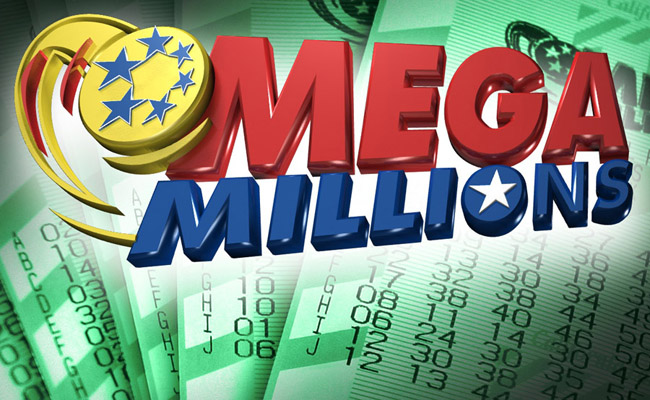USA lottery "Mega-Millions"
Mega Millions (which began as The Big Game in 1996, with the name modified to The Big Game Mega Millions six years later) is an American multi-jurisdictional lottery game; it is offered in 44 states, the District of Columbia, and the U.S. Virgin Islands. The first (The Big Game) Mega Millions drawing was in 2002 (see below.)
The minimum Mega Millions advertised jackpot is $15 million, paid in 30 graduated yearly installments, increasing 5% each year (unless the cash option is chosen; see below for differences by lottery.) The jackpot increases when there is no top-prize winner[1] (see below for information on how the game's jackpot is funded.)
Reflecting common practice among American lotteries, the jackpot is advertised as a nominal value of annual installments. A cash value option (the usual choice), when chosen by a jackpot winner, pays the approximate present value of the installments. Mega Millions' current format began on October 19, 2013; its first drawing was October 22. Mega Millions uses a 5/75 (for the white balls) plus 1/15 (for the "Mega Ball") double matrix to select its winning numbers.
Each game costs $1. Of the 46 Mega Millions jurisdictions, all but California offer an option, called Megaplier (plays with the Megaplier are $2 each) where non-jackpot prizes are multiplied by 2, 3, 4, or 5. The Megaplier was made available to all Mega Millions jurisdictions in January 2011; it began as an option available only in Texas. Mega Millions is drawn at 11:00 p.m. Eastern Time on Tuesday and Friday evenings, including holidays. Mega Millions is administered by a consortium of its 12 original lotteries; the drawings are held at the studios of ABC affiliate WSB-TV in Atlanta, Georgia, supervised by the Georgia Lottery.
In the December 17, 2013 drawing, the current 5/75 + 1/15 format produced its first two jackpot winners, potentially sharing a jackpot worth $648 million (annuity value; with a cash option of $347,639,485), which is the second highest jackpot in Mega Millions and American history. The two jackpot-winning tickets were sold in San Jose, California and in Atlanta, Georgia.
The largest jackpot in Mega Millions, as well as in American lottery, history was $656 million annuity value (with a cash option of $474 million) for the March 30, 2012 drawing, in which there were three jackpot-winning tickets; one each in Illinois, Kansas, and Maryland. All three tickets had been claimed by April 18, with each set of winners choosing the cash option of $158 million, a one-third share. The largest Mega Millions prize was $326 million (annuity) for the lone winning ticket of the November 4, 2014 drawing; it was purchased in New York.

Tickets for The Big Game began to be sold in Georgia, Illinois, Maryland, Massachusetts, Michigan, and Virginia on August 31, 1996. The Big Game was the brainchild of the then-lottery directors Rebecca Paul (of the Georgia Lottery) and Penelope W. Kyle (of the Virginia Lottery.) The Big Game initially was drawn weekly, on Fridays.
The Georgia Lottery was a member of MUSL at the time and wanted to sell both games for the remainder of 1996; however, within a few days, Georgia was forcibly removed from MUSL, returning with the 2010 cross-selling expansion.
Beginning in January 1999, jackpot winners were given the option to receive their prize in cash. In May 1999, New Jersey joined The Big Game, the only jurisdiction to enter as a participant before The Big Game became Mega Millions in 2002.
Ohio and New York joined the consortium on May 15, 2002, when the game was renamed The Big Game Mega Millions , temporarily retaining the old name and the original "gold ball" logo. The "Big Money Ball" became the "Mega Ball." While the game's name was altered, the yellow ball in the new Mega Millions logo continued to read "The Big Game" until February 2003, after which it was replaced with six stars representing the six original members of the consortium. The first (The Big Game) Mega Millions drawing was held two days later on May 17. The Mega Millions trademark is owned by the Illinois Lottery. The first three lotteries to join Mega Millions were Washington (in September 2002), Texas (in 2003) and California (in 2005); California was the last addition to Mega Millions before the cross-sell expansion of 2010. Montana joined Mega Millions on March 1, 2010, the first addition to Mega Millions after the cross-sell expansion.
When Texas joined Mega Millions in 2003, it began offering an option, initially available only to Texas Lottery players, known as the Megaplier, which was similar to the then-current version of Powerball's Power Play. The 11 Mega Millions lotteries without Megaplier on the January 31, 2010 cross-selling date gradually added the multiplier option; by January 2011, all Mega Millions lotteries, except for California, offered the Megaplier. The Texas Lottery owns the trademark to Megaplier.
On June 24, 2005, to commemorate California joining Mega Millions, that night's drawing was held in Hollywood, with Carrie Underwood assisting host Glenn Burns for the draw.
For the November 15, 2005 drawing, a group called "The Lucky 7" held the only jackpot-winning ticket, purchased in Anaheim, California, winning $315 million. They chose the cash option, splitting $175 million before federal withholdings. This remains the largest prize won by a single Mega Millions ticket.
On March 6, 2007, the Mega Millions jackpot reached $390 million, which is the record for the third largest jackpot in U.S. history. The jackpot was shared by two tickets, both matching the numbers of 16-22-29-39-42 and Mega Ball 20. Both winners chose the cash option, with each share $116,557,083 before withholdings.
The New Jersey Lottery, among others, in early 2009 announced it would seek permission to sell Powerball tickets alongside Mega Millions. In October 2009, an agreement between Mega Millions and the MUSL allowed all U.S. lotteries, including New Jersey's, to offer both games. On January 31, 2010, Mega Millions expanded to include 23 Powerball lotteries. As of that date, 35 jurisdictions were participating in Mega Millions. On the same day, 10 existing Mega Millions-participating lotteries began selling Powerball tickets, for a then total of 43 lotteries. Ohio joined Powerball on April 16, 2010, and California joined Powerball on April 8, 2013. On March 1, 2010, Montana became the first Powerball member to add Mega Millions after the cross-sell expansion. Nebraska became the 37th Mega Millions participating member on March 20, 2010, followed by Oregon as the 38th member on March 28, Arizona as the 39th member on April 18, and Maine as 40th Mega Millions participant on May 9, 2010. Colorado and South Dakota added Mega Millions on May 16, 2010, bringing the total to 42 jurisdictions.
The most recent additions to Mega Millions were the U.S. Virgin Islands, in October 2010, and Louisiana, in November 2011. Florida joined Mega Millions on May 15, 2013; the first drawing to include Florida-bought tickets was two days later.
Presumably due to their experience with the Power Play option for Powerball, all 23 lotteries joining Mega Millions on January 31, 2010 immediately offered Megaplier to their players. The Megaplier continues to be drawn by Texas Lottery computers, as California does not offer the multiplier. Montana, offering Powerball before the expansion date, became the 24th lottery to offer the Megaplier, followed by Nebraska (the 25th), Oregon (as the 26th), Arizona (as the 27th) and Maine (as the 28th lottery to offer the Megaplier option). After Colorado and South Dakota joined Mega Millions, this raised the number of lotteries offering the Megaplier to 37.
Mega Millions tickets bought with the Megaplier, beginning September 12, 2010, automatically win $1 million (instead of $250,000) if the five white balls – but excluding the Mega Ball – are matched.
On March 13, 2010, New Jersey became the first Mega Millions participant (just before the cross-sell expansion) to produce a jackpot-winning ticket for Powerball after joining that game. The ticket was worth over $211 million annuity (the cash option was chosen). On May 28, 2010, North Carolina became the first Powerball member (just before the cross-selling expansion) to produce a jackpot-winning Mega Millions ticket after joining Mega Millions, with an annuity jackpot of $12 million.
In January 2012, Mega Millions' rival Powerball was altered; among the changes were a price increase of $1 for each play, as a result, a base game costs $2, or $3 with the Power Play option. There are no plans to change the price of a Mega Millions play, with or without the Megaplier. The price increase for playing Powerball was a major factor in Louisiana deciding to pursue joining Mega Millions, that state's lottery joined Mega Millions on November 16, 2011.
The final 5/56 + 1/46 Mega Millions drawing was held on October 18, 2013; its jackpot of $37 million was not won. The first drawing under the current 5/75 + 1/15 format, which saw the jackpot estimate "leap" to $55 million due to the change in the annuity structure, occurred on October 22. The minimum jackpot is now $15 million with rollovers of at least $5 million. Second prize (5+0) is now $1 million cash. Players now choose 5 of 75 white ball numbers, and 1 "Gold Ball" number out of 15.
The Megaplier option remains; it now includes a 5x multiplier. The Megaplier now applies to all prizes except the jackpot; a 5+0 play with the Megaplier wins $5 million cash.
Former (through October 18, 2013) and current prize tiers, based on a $1 play:
- Match 5+0: $250,000/$1 million
- Match 4+MB: $10,000/$5,000
- Match 4+0: $150/$500
- Match 3+MB: $150/$50
- Match 3+0: $7/$5
- Match 2+MB: $10/$5
- Match 1+MB: $3/$2
- Match 0+MB: $2/$1
Payouts in California remain pari-mutuel.
The current odds of winning the jackpot 1 in about 258.9 million. The overall odds of winning a prize are 1 in 14.71, including the base $1 prize for a "Mega Ball"-only match.
Prizes and odds:
- 5 numbers plus the Mega Ball (5+1): 1 in 258,890,850
- 5 numbers but not the Mega Ball (5+0): 1 in 18,492,204
- 4+1: 1 in 739,688
- 4+0: 1 in 52,835
- 3+1: 1 in 10,720
- 3+0: 1 in 766
- 2+1: 1 in 473
- 1+1: 1 in 56
- Mega Ball only: 1 in 21†[11]
The odds for matching only the Mega Ball, 1 in 21, reflect the possibility of also matching at least one of the white balls. The overall odds of winning any prize in Mega Millions is 1 in 14.7, accounting for all nine prize categories.
The annuity, which was 20 annual payments (no cash option was available) when The Big Game began, changed from 26 equal yearly installments to 30 graduated annual payments (increasing 5% per annum) with the October 19, 2013 format change. Record jackpots
The largest Mega Millions jackpot, advertised as $640 million at the time of the drawing (annuitized) or $462 million (cash value), was drawn on March 30, 2012. The initial estimate for that Friday's drawing (following the March 27 drawing, which was $363 million annuity) was $476 million (later increased to $500 million and again to $540 million); brisk ticket sales pushed the jackpot values, both annuitized (to $656 million) and the cash option ($474 million) higher. The amount spent on Mega Millions for drawings following its previous jackpot win, on January 24, 2012, was at least $1.5 billion. Three jackpot-winning tickets had been confirmed (one each in Illinois, Kansas, and Maryland).
Mega Millions' second-largest jackpot, $648 million, was for the December 17, 2013 drawing. Two winning tickets, one each from California and Georgia, were sold. The holder of the one sold in California potentially will share the jackpot, if claimed. The holder of the Georgia ticket claimed the next morning, selecting the cash option, which amounts to $173,819,742.50 before taxes. (If claimed, the California ticket holder(s) would receive an equal share, but receive a larger after-withholding amount, as California does not tax lottery winnings.)"
Mega Millions' third-largest jackpot, $400 million, was for the March 18, 2014 drawing. Two tickets, one each from Florida and Maryland, split the prize; the winners have not yet chosen their payout option.
Mega Millions' fourth-largest jackpot, $390 million, was for the March 6, 2007 drawing. Two tickets, one each from Georgia and New Jersey, split the then-record prize; both sets of winners chose the cash option, splitting $233 million (as noted below, interest rates change, resulting in different ratios between the cash values and annuity values of jackpots).
Mega Millions' fifth-largest jackpot annuity value ($380 million), and second-largest cash jackpot ($240 million), was for the January 4, 2011 drawing; two tickets, one each from Post Falls, Idaho and Ephrata, Washington, matched all six winning numbers, winning $190 million (annuity) each. The holders of each ticket also chose the cash option.
Two drawing machines are used in Mega Millions. The model used for Mega Millions is the Criterion II, manufactured by Smartplay International of Edgewater Park, New Jersey. The balls are moved around by means of counter-rotating arms which randomly mix the balls. One by one, the five white ball numbers drop through a hole in the bottom of the mixing drum. As of October 19, 2013, there are respectively 75 white balls in the first machine and the 15 gold-colored Mega Balls in the second machine.
0
а
б
в
г
д
е
ж
з
и
к
л
м
a
1-3 4-6 7-9 ... 4786-4788 4789-4791
Each game costs $1. Of the 46 Mega Millions jurisdictions, all but California offer an option, called Megaplier (plays with the Megaplier are $2 each) where non-jackpot prizes are multiplied by 2, 3, 4, or 5. The Megaplier was made available to all Mega Millions jurisdictions in January 2011; it began as an option available only in Texas. Mega Millions is drawn at 11:00 p.m. Eastern Time on Tuesday and Friday evenings, including holidays. Mega Millions is administered by a consortium of its 12 original lotteries; the drawings are held at the studios of ABC affiliate WSB-TV in Atlanta, Georgia, supervised by the Georgia Lottery.
In the December 17, 2013 drawing, the current 5/75 + 1/15 format produced its first two jackpot winners, potentially sharing a jackpot worth $648 million (annuity value; with a cash option of $347,639,485), which is the second highest jackpot in Mega Millions and American history. The two jackpot-winning tickets were sold in San Jose, California and in Atlanta, Georgia.
The largest jackpot in Mega Millions, as well as in American lottery, history was $656 million annuity value (with a cash option of $474 million) for the March 30, 2012 drawing, in which there were three jackpot-winning tickets; one each in Illinois, Kansas, and Maryland. All three tickets had been claimed by April 18, with each set of winners choosing the cash option of $158 million, a one-third share. The largest Mega Millions prize was $326 million (annuity) for the lone winning ticket of the November 4, 2014 drawing; it was purchased in New York.

The Georgia Lottery was a member of MUSL at the time and wanted to sell both games for the remainder of 1996; however, within a few days, Georgia was forcibly removed from MUSL, returning with the 2010 cross-selling expansion.
Beginning in January 1999, jackpot winners were given the option to receive their prize in cash. In May 1999, New Jersey joined The Big Game, the only jurisdiction to enter as a participant before The Big Game became Mega Millions in 2002.
Ohio and New York joined the consortium on May 15, 2002, when the game was renamed The Big Game Mega Millions , temporarily retaining the old name and the original "gold ball" logo. The "Big Money Ball" became the "Mega Ball." While the game's name was altered, the yellow ball in the new Mega Millions logo continued to read "The Big Game" until February 2003, after which it was replaced with six stars representing the six original members of the consortium. The first (The Big Game) Mega Millions drawing was held two days later on May 17. The Mega Millions trademark is owned by the Illinois Lottery. The first three lotteries to join Mega Millions were Washington (in September 2002), Texas (in 2003) and California (in 2005); California was the last addition to Mega Millions before the cross-sell expansion of 2010. Montana joined Mega Millions on March 1, 2010, the first addition to Mega Millions after the cross-sell expansion.
When Texas joined Mega Millions in 2003, it began offering an option, initially available only to Texas Lottery players, known as the Megaplier, which was similar to the then-current version of Powerball's Power Play. The 11 Mega Millions lotteries without Megaplier on the January 31, 2010 cross-selling date gradually added the multiplier option; by January 2011, all Mega Millions lotteries, except for California, offered the Megaplier. The Texas Lottery owns the trademark to Megaplier.
On June 24, 2005, to commemorate California joining Mega Millions, that night's drawing was held in Hollywood, with Carrie Underwood assisting host Glenn Burns for the draw.
For the November 15, 2005 drawing, a group called "The Lucky 7" held the only jackpot-winning ticket, purchased in Anaheim, California, winning $315 million. They chose the cash option, splitting $175 million before federal withholdings. This remains the largest prize won by a single Mega Millions ticket.
On March 6, 2007, the Mega Millions jackpot reached $390 million, which is the record for the third largest jackpot in U.S. history. The jackpot was shared by two tickets, both matching the numbers of 16-22-29-39-42 and Mega Ball 20. Both winners chose the cash option, with each share $116,557,083 before withholdings.
The New Jersey Lottery, among others, in early 2009 announced it would seek permission to sell Powerball tickets alongside Mega Millions. In October 2009, an agreement between Mega Millions and the MUSL allowed all U.S. lotteries, including New Jersey's, to offer both games. On January 31, 2010, Mega Millions expanded to include 23 Powerball lotteries. As of that date, 35 jurisdictions were participating in Mega Millions. On the same day, 10 existing Mega Millions-participating lotteries began selling Powerball tickets, for a then total of 43 lotteries. Ohio joined Powerball on April 16, 2010, and California joined Powerball on April 8, 2013. On March 1, 2010, Montana became the first Powerball member to add Mega Millions after the cross-sell expansion. Nebraska became the 37th Mega Millions participating member on March 20, 2010, followed by Oregon as the 38th member on March 28, Arizona as the 39th member on April 18, and Maine as 40th Mega Millions participant on May 9, 2010. Colorado and South Dakota added Mega Millions on May 16, 2010, bringing the total to 42 jurisdictions.
The most recent additions to Mega Millions were the U.S. Virgin Islands, in October 2010, and Louisiana, in November 2011. Florida joined Mega Millions on May 15, 2013; the first drawing to include Florida-bought tickets was two days later.
Presumably due to their experience with the Power Play option for Powerball, all 23 lotteries joining Mega Millions on January 31, 2010 immediately offered Megaplier to their players. The Megaplier continues to be drawn by Texas Lottery computers, as California does not offer the multiplier. Montana, offering Powerball before the expansion date, became the 24th lottery to offer the Megaplier, followed by Nebraska (the 25th), Oregon (as the 26th), Arizona (as the 27th) and Maine (as the 28th lottery to offer the Megaplier option). After Colorado and South Dakota joined Mega Millions, this raised the number of lotteries offering the Megaplier to 37.
Mega Millions tickets bought with the Megaplier, beginning September 12, 2010, automatically win $1 million (instead of $250,000) if the five white balls – but excluding the Mega Ball – are matched.
On March 13, 2010, New Jersey became the first Mega Millions participant (just before the cross-sell expansion) to produce a jackpot-winning ticket for Powerball after joining that game. The ticket was worth over $211 million annuity (the cash option was chosen). On May 28, 2010, North Carolina became the first Powerball member (just before the cross-selling expansion) to produce a jackpot-winning Mega Millions ticket after joining Mega Millions, with an annuity jackpot of $12 million.
In January 2012, Mega Millions' rival Powerball was altered; among the changes were a price increase of $1 for each play, as a result, a base game costs $2, or $3 with the Power Play option. There are no plans to change the price of a Mega Millions play, with or without the Megaplier. The price increase for playing Powerball was a major factor in Louisiana deciding to pursue joining Mega Millions, that state's lottery joined Mega Millions on November 16, 2011.
The final 5/56 + 1/46 Mega Millions drawing was held on October 18, 2013; its jackpot of $37 million was not won. The first drawing under the current 5/75 + 1/15 format, which saw the jackpot estimate "leap" to $55 million due to the change in the annuity structure, occurred on October 22. The minimum jackpot is now $15 million with rollovers of at least $5 million. Second prize (5+0) is now $1 million cash. Players now choose 5 of 75 white ball numbers, and 1 "Gold Ball" number out of 15.
The Megaplier option remains; it now includes a 5x multiplier. The Megaplier now applies to all prizes except the jackpot; a 5+0 play with the Megaplier wins $5 million cash.
Former (through October 18, 2013) and current prize tiers, based on a $1 play:
- Match 5+0: $250,000/$1 million
- Match 4+MB: $10,000/$5,000
- Match 4+0: $150/$500
- Match 3+MB: $150/$50
- Match 3+0: $7/$5
- Match 2+MB: $10/$5
- Match 1+MB: $3/$2
- Match 0+MB: $2/$1
Payouts in California remain pari-mutuel.
The current odds of winning the jackpot 1 in about 258.9 million. The overall odds of winning a prize are 1 in 14.71, including the base $1 prize for a "Mega Ball"-only match.
Prizes and odds:
- 5 numbers plus the Mega Ball (5+1): 1 in 258,890,850
- 5 numbers but not the Mega Ball (5+0): 1 in 18,492,204
- 4+1: 1 in 739,688
- 4+0: 1 in 52,835
- 3+1: 1 in 10,720
- 3+0: 1 in 766
- 2+1: 1 in 473
- 1+1: 1 in 56
- Mega Ball only: 1 in 21†[11]
The odds for matching only the Mega Ball, 1 in 21, reflect the possibility of also matching at least one of the white balls. The overall odds of winning any prize in Mega Millions is 1 in 14.7, accounting for all nine prize categories.
The annuity, which was 20 annual payments (no cash option was available) when The Big Game began, changed from 26 equal yearly installments to 30 graduated annual payments (increasing 5% per annum) with the October 19, 2013 format change. Record jackpots
The largest Mega Millions jackpot, advertised as $640 million at the time of the drawing (annuitized) or $462 million (cash value), was drawn on March 30, 2012. The initial estimate for that Friday's drawing (following the March 27 drawing, which was $363 million annuity) was $476 million (later increased to $500 million and again to $540 million); brisk ticket sales pushed the jackpot values, both annuitized (to $656 million) and the cash option ($474 million) higher. The amount spent on Mega Millions for drawings following its previous jackpot win, on January 24, 2012, was at least $1.5 billion. Three jackpot-winning tickets had been confirmed (one each in Illinois, Kansas, and Maryland).
Mega Millions' second-largest jackpot, $648 million, was for the December 17, 2013 drawing. Two winning tickets, one each from California and Georgia, were sold. The holder of the one sold in California potentially will share the jackpot, if claimed. The holder of the Georgia ticket claimed the next morning, selecting the cash option, which amounts to $173,819,742.50 before taxes. (If claimed, the California ticket holder(s) would receive an equal share, but receive a larger after-withholding amount, as California does not tax lottery winnings.)"
Mega Millions' third-largest jackpot, $400 million, was for the March 18, 2014 drawing. Two tickets, one each from Florida and Maryland, split the prize; the winners have not yet chosen their payout option.
Mega Millions' fourth-largest jackpot, $390 million, was for the March 6, 2007 drawing. Two tickets, one each from Georgia and New Jersey, split the then-record prize; both sets of winners chose the cash option, splitting $233 million (as noted below, interest rates change, resulting in different ratios between the cash values and annuity values of jackpots).
Mega Millions' fifth-largest jackpot annuity value ($380 million), and second-largest cash jackpot ($240 million), was for the January 4, 2011 drawing; two tickets, one each from Post Falls, Idaho and Ephrata, Washington, matched all six winning numbers, winning $190 million (annuity) each. The holders of each ticket also chose the cash option.
Two drawing machines are used in Mega Millions. The model used for Mega Millions is the Criterion II, manufactured by Smartplay International of Edgewater Park, New Jersey. The balls are moved around by means of counter-rotating arms which randomly mix the balls. One by one, the five white ball numbers drop through a hole in the bottom of the mixing drum. As of October 19, 2013, there are respectively 75 white balls in the first machine and the 15 gold-colored Mega Balls in the second machine.
 |  |
 |  |
